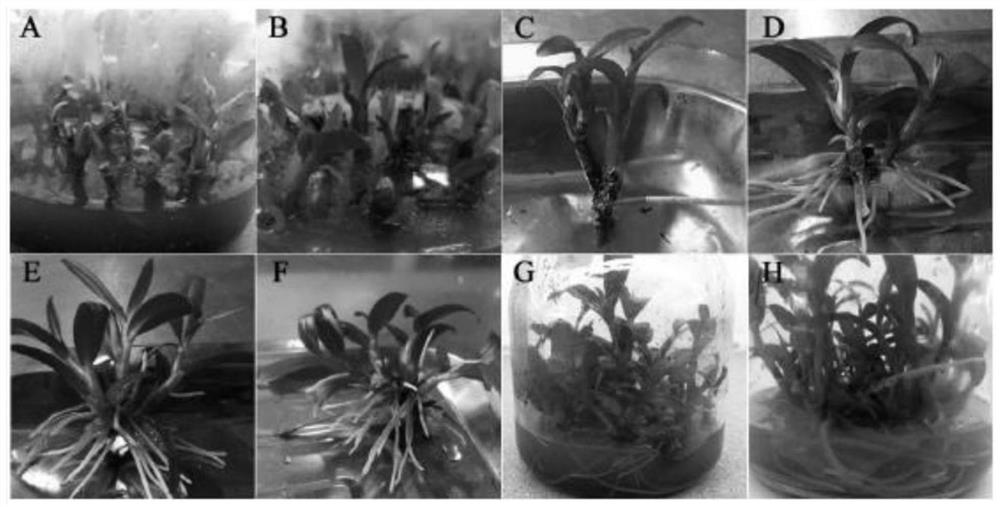Artificial high-efficiency clonal propagation method of dendrobium anosmum
A technology of Dendrobium sandalwood and clones, applied in the field of ornamental plant reproduction, can solve the problems of difficulty in large-scale production and promotion in large areas, low rate of protocorm differentiation into seedlings, large variation of seedlings, etc., so as to improve the survival rate of seedling domestication. , the effect of shortening the breeding cycle and fast proliferation
- Summary
- Abstract
- Description
- Claims
- Application Information
AI Technical Summary
Problems solved by technology
Method used
Image
Examples
Embodiment 1
[0054] A kind of artificial high-efficiency clonal propagation method of dendrobium dendrobii comprises the following steps:
[0055] 1. Acquisition of explants: Select healthy plants with good growth potential, no damage by diseases and insect pests, and no deformities, and get the stem section under the tip of the shoot, including the second to third sections, and cut it into about 1.0cm long stem section with a scalpel.
[0056] 2. Remove the leaves from the section of the segmented stem in step 1 and wash it with running water, soak it in a washing powder solution with a mass ratio of 15% for 10 minutes, rinse it with running water for 30 minutes, and place it in an ultra-clean workbench; soak it in an ethanol solution with a volume ratio of 75% 10-15s, then sterilized with 0.1% mercuric chloride aqueous solution by mass ratio for 6 minutes, during which the bottle body was shaken constantly to achieve the best sterilization effect, and finally rinsed with sterile water for...
Embodiment 2
[0068] A kind of artificial high-efficiency clonal propagation method of dendrobium dendrobii comprises the following steps:
[0069] 1. Acquisition of explants: Select a strong plant with good growth potential, no damage by diseases and insect pests, and no deformity, and get the stem section under the tip of the shoot, including the 2nd to 4th sections, and cut it into about 1.5cm long stem section with a scalpel.
[0070] 2. Remove the leaves from the section of the segmented stem in step 1 and wash it with running water, soak it in a washing powder solution with a mass ratio of 15% for 10 minutes, rinse it with running water for 30 minutes, and place it in an ultra-clean workbench; soak it in an ethanol solution with a volume ratio of 75% 10-15s, then sterilized with 0.1% mercuric chloride aqueous solution by mass ratio for 6 minutes, during which the bottle body was shaken constantly to achieve the best sterilization effect, and finally rinsed with sterile water for 3 time...
Embodiment 3
[0081] A kind of artificial high-efficiency clonal propagation method of dendrobium dendrobii comprises the following steps:
[0082] 1. Acquisition of explants: Select robust plants with good growth potential, no damage by diseases and insect pests, and no deformities, and get the stem section under the tip of the shoot, including the 2nd to 5th sections, and cut it into about 2.0cm long stem sections with a scalpel.
[0083] 2. Remove the leaves from the section of the segmented stem in step 1 and wash it with running water, soak it in a washing powder solution with a mass ratio of 15% for 10 minutes, rinse it with running water for 30 minutes, and place it in an ultra-clean workbench; soak it in an ethanol solution with a volume ratio of 75% 10-15s, then sterilized with 0.1% mercuric chloride aqueous solution by mass ratio for 6 minutes, during which the bottle body was shaken constantly to achieve the best sterilization effect, and finally rinsed with sterile water for 3 ti...
PUM
 Login to View More
Login to View More Abstract
Description
Claims
Application Information
 Login to View More
Login to View More - R&D
- Intellectual Property
- Life Sciences
- Materials
- Tech Scout
- Unparalleled Data Quality
- Higher Quality Content
- 60% Fewer Hallucinations
Browse by: Latest US Patents, China's latest patents, Technical Efficacy Thesaurus, Application Domain, Technology Topic, Popular Technical Reports.
© 2025 PatSnap. All rights reserved.Legal|Privacy policy|Modern Slavery Act Transparency Statement|Sitemap|About US| Contact US: help@patsnap.com



